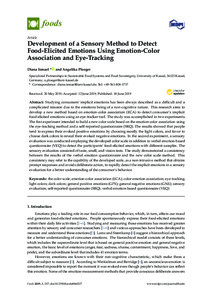| dc.date.accessioned | 2019-09-10T13:31:03Z | |
| dc.date.available | 2019-09-10T13:31:03Z | |
| dc.date.issued | 2019-06-18 | |
| dc.identifier | doi:10.17170/kobra-20190910679 | |
| dc.identifier.uri | http://hdl.handle.net/123456789/11309 | |
| dc.description.sponsorship | Gefördert durch den Publikationsfonds der Universität Kassel | |
| dc.language.iso | eng | |
| dc.rights | Urheberrechtlich geschützt | |
| dc.rights.uri | https://rightsstatements.org/page/InC/1.0/ | |
| dc.subject | the color scale | eng |
| dc.subject | emotion-color association (ECA) | eng |
| dc.subject | color-emotion association | eng |
| dc.subject | eye-tracking | eng |
| dc.subject | light colors | eng |
| dc.subject | dark colors | eng |
| dc.subject | general positive emotions (GPE) | eng |
| dc.subject | general negative emotions (GNE) | eng |
| dc.subject | sensory evaluation | eng |
| dc.subject | self-reported questionnaire (SRQ) | eng |
| dc.subject | verbal emotion-based questionnaire (VEQ) | eng |
| dc.subject.ddc | 630 | |
| dc.title | Development of a Sensory Method to Detect Food-Elicited Emotions Using Emotion-Color Association and Eye-Tracking | eng |
| dc.type | Aufsatz | |
| dcterms.abstract | Studying consumers’ implicit emotions has been always described as a difficult and a complicated mission due to the emotions being of a non-cognitive nature. This research aims to develop a new method based on emotion-color association (ECA) to detect consumer’s implicit food-elicited emotions using an eye-tracker tool. The study was accomplished in two experiments. The first experiment intended to build a new color scale based on the emotion-color association using the eye-tracking method and a self-reported questionnaire (SRQ). The results showed that people tend to express their evoked positive emotions by choosing mostly the light colors, and favor to choose dark colors to reveal their evoked negative emotions. In the second experiment, a sensory evaluation was conducted employing the developed color scale in addition to verbal emotion-based questionnaire (VEQ) to detect the participants’ food-elicited emotions with different samples. The sensory evaluation consisted of taste, smell, and vision tests. The study demonstrated a consistency between the results of the verbal emotion questionnaire and the new color scale method. This consistency may refer to the capability of the developed scale, as a non-intrusive method that obtains prompt responses and avoids deliberate action, to rapidly detect the implicit emotions in a sensory evaluation for a better understanding of the consumer’s behavior. | eng |
| dcterms.accessRights | open access | |
| dcterms.creator | Ismael, Diana | |
| dcterms.creator | Ploeger, Angelika | |
| dc.relation.doi | doi:10.3390/foods8060217 | |
| dc.type.version | publishedVersion | |
| dcterms.source.identifier | ISSN 2304-8158 | |
| dcterms.source.issue | Issue 6 | |
| dcterms.source.journal | Foods | eng |
| dcterms.source.pageinfo | 217 | |
| dcterms.source.volume | Volume 8 | |


